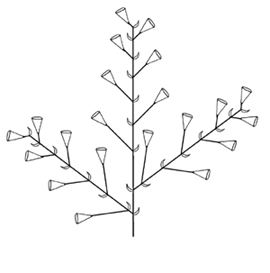Arundo L.
carrizo, arundo, giant reed, oboe cane
Poaceae
bamboo and various grasses when juvenile
Old World (Mediterranean)
Arundo donax L.
introduced into and common throughout the New World
Arundo donax is a significant invasive weed throughout the world, and listed as a noxious weed in numerous countries.
tall, emergentemergent:
(adj) (syn. emersed) with parts raised out of the water; extending up out of the water
or terrestrialterrestrial:
(adj) growing on land as opposed to living in water
grass
Very tall (up to 6 m). Rhizomerhizome:
(n) an underground stem, usually growing horizontally, from which both roots and shoots emerge directly; the thick, above-ground stem of ferns
 creeping, hard and thick, with knots. Leaves caulinecauline:
creeping, hard and thick, with knots. Leaves caulinecauline:
(adj) pertaining to or belonging to the stem
, up to 100 cm long and 7 cm wide; rounded at base and tapering to a point; ligules large, papery. Inflorescenceinflorescence:
(n) the arrangement of flowers on the floral axis
 a large (up to 60 cm long), dense, erect and feathery, whitish to brown paniclepanicle:
a large (up to 60 cm long), dense, erect and feathery, whitish to brown paniclepanicle:
(n) an indeterminate, branched (often much-branched) inflorescence; the ultimate units may be of a different inflorescence type
 ; spikelets solitary, stalked, each with 2-7 flowers. Caryopses dispersed by wind and water.
; spikelets solitary, stalked, each with 2-7 flowers. Caryopses dispersed by wind and water.
The cultivar Arundo donax 'Variegata' is smaller than A. donax (to 3 m), with cream and green variegated leaves.
wetlands and riparianriparian:
(adj) growing by rivers or streams; of, adjacent to, or living on, the banks of a river, lake, pond, etc.
habitats
A genus of five species. Arundo donax can have a large effect on riparianriparian:
(adj) growing by rivers or streams; of, adjacent to, or living on, the banks of a river, lake, pond, etc.
ecosystems, where it can increase fires, accelerate erosion, and replace native species with poor habitat. Arundo donax 'Variegata' is not known to be weedy and rarely flowers.